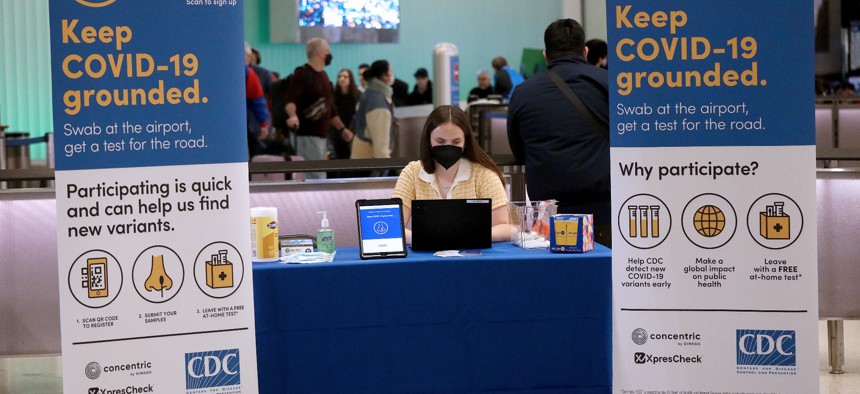
A new report from the National Academy of Public Administration and the IBM Center for the Business of Government details how agencies can develop collaborative networks to mitigate the impact of whole of society events, such as the COVID-19 pandemic. Gary Coronado / GETTY IMAGES
With catastrophes on the rise, a new report outlines how agencies can integrate their response
A new study from the National Academy of Public Administration and the IBM Center for the Business of Government details strategies the federal government can take to absorb the shock of unprecedented national and international events and mitigate their institutional risks.
In the wake of a global pandemic, natural disasters and international armed conflict, federal agencies are having to become more nimble in the face of disruptive events and how they can impact government response.
But a new report from the National Academy of Public Administration, the IBM Institute for Business Value and the IBM Center for the Business of Government is offering strategies on how agencies can better mitigate risk and stay resilient to the effects of unprecedented events by partnering across public and private sectors and across federal, state and local governments.
“What we wanted to do and what we found is what does it look like when these traditional management categories — planning, risk management, workforce, using data — when they get scaled into collaborative enterprises, that is they lose their agency-centric approach,” Chris Mihm, adjunct professor of public administration and international affairs at Syracuse University and lead author of the report, told Government Executive.
“And second, [what happens when] they get applied to situations of shocks and, in many cases these shocks are catastrophic. I think that the path going forward is for governments of all levels to continue to identify what are those shocks. Those potential shocks that are out there that can fundamentally alter or undermine their capacity to deliver services and the abilities of their individuals and their communities to respond.”
The report points to some of those shocks that have already occurred, such as the federal response to Hurricane Katrina or black swan events like the COVID-19 pandemic, that have crosscutting impacts across agencies, state and local governments and public and private sectors.
Because disruptions can reach across agencies and governments in their impacts, the report strategizes ways for agencies to develop more collaborative networks that can deploy shared resources to the threat.
Mihm said that by building networks of partners that can plan for these crosscutting shocks through planning like memoranda of agreement, continuous training, tabletop exercises and wargaming, they can seek to mitigate some of their impacts.
“On coordinating the networks, that is an enormous challenge for organizations at all levels of government,” he said. “What it basically turns on is that old cliché: the center of the crisis is not the time to be exchanging business cards. So successful networks, especially when they are dealing with future shocks are going to be successful if they establish beforehand all the routines, the understandings, the relationships — both personal and institutional — among the individuals and the organizations so when they are in the middle of a crisis, they can rely on each other.”
The report includes eight imperatives for agencies to consider; including often-discussed best practices like improving communication, fast-tracking innovation and pursing data-driven decision-making; alongside other goals like developing cross-agency relationships and joint training practices to coincide with workforce development and continuous reskilling.
The report points to practices like developing centers of excellence and shared services to help serve as the governance for setting up such networks. Mihm pointed to the work of agencies like the Federal Emergency Management Agency for its cross-segment engagement in response to natural disasters as an example.
The report leans on past work done by NAPA and the IBM Center, including “Managing the Next Crisis: Twelve Principles for Dealing with Viral Uncertainty,” and offers key actions for stakeholders to consider in building outcome-based networks centered on potential shocks.
“Successful organizations’ collaborative efforts have an underpinning of a governance structure in place,” said Mihm, citing other successful organizations like the U.S. Interagency Council on Homelessness and other efforts where there are dedicated implementation teams, such as reforming security clearance processing, among others.
The report also calls for deploying generative artificial intelligence to help optimize response to crosscutting shocks, as well as building continuous reskilling efforts into the federal workforce to help address future challenges.
“We are dealing with current staffing shortages that are mission-critical and we’re not sure we have the understanding, the capacity and the tools in place to address those,” said Mihm. “Which is why the focus on reskilling is so important. It’s not just learning additional tools or keeping up to date on your current occupation. It’s about understanding that for large parts of the workforce, they are going to need to go in a different direction if they are going to be successful.”
NEXT STORY: A tall task awaits O’Malley at Social Security







